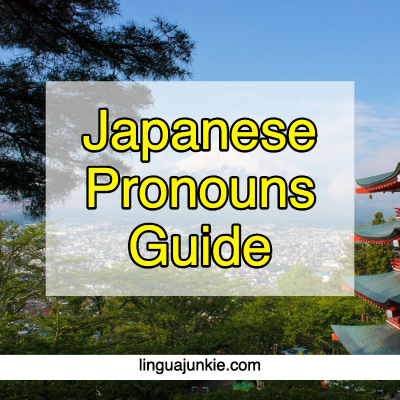Want to learn about Japanese pronouns?
Well, welcome! Today, you’ll learn about
- The Basic Workings of Pronouns
- How to Say I, You, He, She and so On
- (Japanese Pronouns List Included)
- And the Japanese Pronouns Gender Nuances
Let’s take a look.

1. Introduction to Japanese Pronouns
Pronouns are words like I, you, he, she, it, they, and so on.
And of course, they exist in Japanese. But…
Japanese personal pronouns are tricky because of the wide variety you can use. Even something simple like saying “I” can have at least six different word choices in Japanese. Plus, to add on some more trickiness, you don’t always need to use pronouns in order to speak correctly.
So, Japanese pronouns are like additional words that add more meaning and context. This is why choosing the correct word for the pronoun can depend on what nuance you’re trying to show.
For example, if you want to sound masculine, you can use the word ore instead of watashi for “I.”
As a tip for Japanese learners: it’s a good idea also to take out pronouns when you don’t need them. Us English speakers overuse pronouns when speaking in Japanese because we’re used to using them in English. But, one of the best ways to sound natural in Japanese is by taking out pronouns when they don’t need to be used.
Now that you know the deal with Japanese pronouns, let’s take a look at the actual words.
1) “I”
First, let’s look at all the ways to say “I,” “me” or “myself” in Japanese. You’ll find that some of these should only be used by guys and some by ladies. So, there’s a bit of Japanese pronoun gender nuance to master.
1.1) わたし / Watashi
Watashi is the most generic and neutral way to say “I” in Japanese. If you don’t know which one to use, you should choose this one. This is gender neutral.
1.2) わたくし / Watakushi
Watakushi is a more formal way to say watashi. It is usually only used in political speeches or formal writing.
1.3) あたし / Atashi
Women sometimes say atashi to give off a cool vibe. This is a variation on watashi. So, this is very much one of the most common Japanese female pronouns.
1.4) ぼく / Boku
Men use this to refer to themselves. It’s casual and can sound a bit childish. You should only use this when you’re with friends and family.
5) おれ / Ore
Ore is a harsher way to say “I” that men tend to use. Also, used amongst friends.
6) うち / Uchi
When referring to yourself, you can also use uchi. This is very informal and is more for talking with your friends and family.
2)“You”
Now, how do you say you in Japanese? Let’s look at the Japanese second person pronouns. There are plenty — polite, casual, and rude.
2.1) あなた / Anata
This is a neutral way to say “you” and what you’ll see in textbooks and translations. However, it it can actually come across as rude if you’re not careful. In general, if you want to say “you” in Japanese, you should just say the person’s name instead of saying anata.
2.2) きみ / Kimi
A casual way to say “you,” kimi is usually said by men towards those of lower social status or hierarchy. For example, underlings at work or school friends of a lower grade.
2.3) おまえ / Omae
Omae is a harsher way to say “you,” that is a part of masculine speech. It is said between men or when you are looking down at someone. Something you can use with friends but also a word that will get you into trouble if you’re use it elsewhere.
2.4) てめえ / Temee
This is even ruder than omae, and sounds strong. It is used by those who are trying to sound aggressive.
2.5) きさま / Kisama
Kisama can act like a swear word when you want to say “you” but in an insulting way.
Now that we’ve covered the “you,” let’s move on.
3) “He” / “She”
Now, let’s look at the Japanese third person pronouns.
3.1) かれ / Kare
Kare applies to men and means “he” or “him.”
3.2) かのじょ/ Kanojo
Kanojo is a word used towards women and means “she” or “her.”
3.3) やつ / Yatsu
This is an offensive way to say “he” or “she.” It can apply to any gender and sounds like you’re mad at the other person.
3.4) やろう / Yarou
Similar to yatsu, yarou is also a rude way to say “he” or “she.” Men tend to say this but it can refer to both men and women. It means something like “scum” and can be an insult.
3.5) あの / Ano + type of person
You can also make a “he” or “she” word by adding the type of person to ano. You can use it for hito meaning “person,” dansei meaning “man,” josei meaning “woman,” and more. Ano means “that” in English. For example, if you see a man walking, you can say ano dansei (that man) to refer to him.
4) Plural “you”
To make the plural form of you, add tachi or ra to the pronoun for “you.” For example, you can take the word anata and turn it into anata tachi, which means “you all.” When converting “you” words to the plural form, the nuance of the word stays the same. With a word for “you” like temee, which is considered to be rude, that would also carry over when you make it temee ra.
Whether to use tachi or ra depends on the situation. Tachi tends to sound more formal than ra, but you can often use either one. Names can also be turned into a plural “you”. If you see someone named Yamada-san with many other people, you can address them all by saying Yamada-san tachi.
Here are some examples of plural “you”:
- あなたたち / Anata tachi
- きみたち / Kimi tachi
- おまえら / Omae ra
- てめえら / Temee ra
- きさまら / Kisama ra
5) “We”
How do you say we in Japanese? Well…
For “we”, the Japanese language doesn’t have specific words. Instead, it is created by adding tachi or ra to the pronoun for “I”. This is similar to the way it works with plural “you”. For example, you can say watashi tachi or ore ra.
Here are some examples of “we”:
- わたしたち / Watashi tachi
- わたくしたち / Watakushi tachi
- あたしら / Atashi ra
- ぼくたち / Boku tachi
- おれら / Ore ra
- うちら / Uchi ra
6) “They”
How do you say they in Japanese?
The word for “they” is formed by adding tachi or ra to the ends of the pronouns for him or her. This works similarly to both “we” and plural “you.” You can even add it to pronouns that are formed by ano + type of person. For example, ano josei becomes ano josei tachi, meaning “those women” or “they.”
Here are some examples of “they”:
- かれら / Kare ra
- かのじょたち / Kanojo tachi
- やつら / Yatsu ra
- やろうたち / Yarou tachi
- あの女性たち / Ano josei tachi
- あの人たち / Ano hito tachi
Now You Know About Japanese Pronouns.
Hopefully now you understand a bit more about Japanese personal pronouns.
Long story short, you can and should omit pronouns when speaking in Japanese.
You’d only need to use them to add context and meaning to the conversation.
And once you use them, there’s no point in repeating them — because everyone’s aware of the context. Unlike in English, where we keep saying “you, you, you, you,” in Japanese once is enough for everyone to know.
Any questions?
Leave a comment!
– The Main Lingua Junkie
